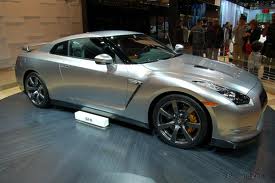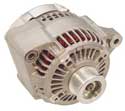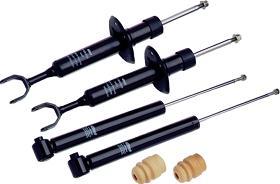RIDE HEIGHT
"Static" ride height is when the vehicle is at rest. "Dynamic" ride height is the average ride height that normally occurs as a vehicle travels down the road. Measuring ride height is a way to check for spring sag, which is important because the height of the springs affects camber, caster and toe. Low ride height indicates weak or sagging springs. Ride height should be within specifications before the wheels are aligned.
HOW RIDE HEIGHT AFFECTS ALIGNMENT Ride height determines where the control arms operate within their normal range of travel. This is especially important with SLA and wishbone strut suspensions. When a suspension is designed by the vehicle manufacturer, the control arms are positioned to operate at a certain height with respect to the road and other chassis parts. That position determines the amount
 and direction of camber change that occurs as the suspension moves from jounce to rebound. If the springs are weak and the
suspension has sagged two or more inches below the specified ride height, the arms are forced to operate above their normal
rest position and beyond their normal range of travel -- which can cause undesirable changes in camber and toe.
Differences in ride height front-to-rear can also upset the steering geometry of the front suspension. Raising or lowering the
rear of the vehicle will change the angle of the steering axis, which in turn changes caster (SEE CASTER). Depending on the
amount of change, it may have an adverse effect on steering stability, effort and returnability.
and direction of camber change that occurs as the suspension moves from jounce to rebound. If the springs are weak and the
suspension has sagged two or more inches below the specified ride height, the arms are forced to operate above their normal
rest position and beyond their normal range of travel -- which can cause undesirable changes in camber and toe.
Differences in ride height front-to-rear can also upset the steering geometry of the front suspension. Raising or lowering the
rear of the vehicle will change the angle of the steering axis, which in turn changes caster (SEE CASTER). Depending on the
amount of change, it may have an adverse effect on steering stability, effort and returnability.Other clues to look for that may tell you a vehicle has a ride height problem:
* Caster readings out of spec. Depending on whether the front or rear of the vehicle is low, a certain amount of caster will be added to the front wheels (unless both ends are equally high or low, in which case there is no net change). If the nose is low, negative caster is added to the front wheels. If the rear end is low, positive caster is added to the front wheels.
* Camber readings out of spec. Changes in front or rear ride height can alter front camber alignment (and rear camber on vehicles with independent rear suspensions) especially when there's a difference in ride height side-to-side. How much the camber readings change will depend on the amount of sag and suspension geometry.
* Increased tire wear. Changes in ride height that alter wheel geometry can accelerate tire wear -- particularly on suspensions where toe is sensitive to changes in ride height.
* Suspension bottoming. If the suspension has less total travel distance because of weak or sagging springs, it will be more apt to bottom out on bumps or when the vehicle is carrying loads. This, in turn, can accelerate suspension wear and may even damage the suspension stops, shocks, struts or other components. If the suspension stops show evidence of bottoming, and/or the coils on coil springs have been contacting one another, the springs may need replacing.
* Complaints about bottoming, excessive body sway when cornering, nose dive when braking, vehicle instability when towing a trailer or hauling loads, and/or uneven braking or traction may all indicate adverse changes in ride height as a result of weak or sagging springs.
MEASURING RIDE HEIGHT Ride height is difficult to gauge by sight alone unless a vehicle is sagging badly or leaning to one side. So it should always be measured and compared to specifications to determine if it is within an acceptable range. Some manufacturers allow up to an inch or more of sag (but generally no more than two inches) before ride height is considered out of specification. Ride height should be measured both front and rear, and on both sides.
The point where ride height is measured is important. Vehicle manufacturers specify various reference points on the frame, body, fender, bumper or suspension, so make sure you know where the measurement is supposed to be taken. Aftermarket ride height specification charts are also available that use the distance between the edge of the fender opening and the center of the wheel as a common reference point.
Side-to-side ride height comparisons with a yardstick or tape measure (even without reference specifications) are useful because they can help you identify sagging springs as well as frame and body misalignment. A difference of more than an inch side-to-side may be enough to cause the vehicle to lead towards the shorter side.
CORRECTING RIDE HEIGHT PROBLEMS When ride height is found to be below specs, repairs should be recommended before any alignment work is done. When coil springs are an inch or less below specifications, shims may be installed in or under the springs to restore ride height. But shims do not restore spring rates, so ride harshness may increase with this approach. Installing a shim under a spring to raise ride height also reduces the working range of the spring, which may increase the risk of the spring bottoming. A better solution would be to recommend new springs.
With leaf springs, longer spring shackles may be installed to compensate somewhat for sag. But the best approach here is also new springs. With torsion bar suspensions, the torsion bars can usually be adjusted to compensate for sag. If ride height is unusually low, a visual inspection of the springs would be in order to check for breakage. Coil springs sometimes break as do leaf springs. Rust can also weaken or loosen torsion bar mountings as well as strut towers inside





